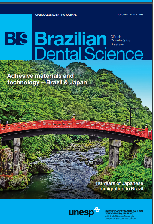Influence of indirect reinforcements on the flexural strength of a thermally activated acrylic resin used for complete dentures
DOI:
https://doi.org/10.14295/bds.2018.v21i2.1539Abstract
Objetive: This research aimed to verify the performance of thermally activated acrylic resin (TAAR) combined with a mix of glass and aramid fibers and/or composite resin of indirect use by a tree point bending test. Material and Methods: Ten samples, with 65 x 10 x 2.5 mm, were prepared for each group (n = 10): CO, control of only TAAR; CR, in which an 60 mm indirect composite resin was polymerized together with the acrylic resin during the thermo-polymerization cycle; SS, in which ceramic glass mixed with aramid fibers cut 60 mm in length were incorporated into the samples; and SC, in which the same fibers were incorporated with addiction of the indirect composite resin. A three-point flexural strength test was performed with a universal testing machine with a load of 50KgF at a speed of 5 mm/min in the center of the samples supported by a suitable device. The reinforced face was placed to the tensile side. The statistical one-way ANOVA and Tukey tests were made with a significance level of 95%. Results: The mean value for the CO was 60,27 ± 24,18 MPa, for CR it was 38,39±12,75 MPa, for SS it was 79,97±12,75 Mpa and for CS it was 32,40±9,05 MPa. Conclusion: The use of glass and aramid fibers at the base of a TAAR increased the three-point flexural strength, however when indirect composite resin was incorporated, a significant drop of this mechanical property was observed.
Keywords
Acrylic resin; Complete denture; Composite resin.
Downloads
Downloads
Published
How to Cite
Issue
Section
License
Brazilian Dental Science uses the Creative Commons (CC-BY 4.0) license, thus preserving the integrity of articles in an open access environment. The journal allows the author to retain publishing rights without restrictions.
=================




























